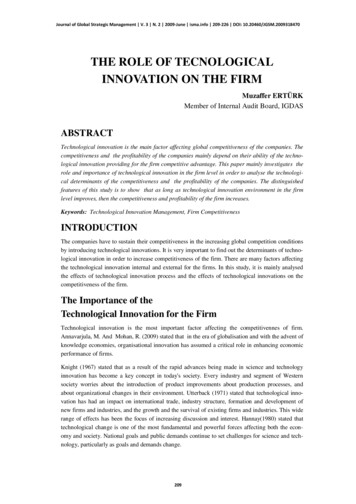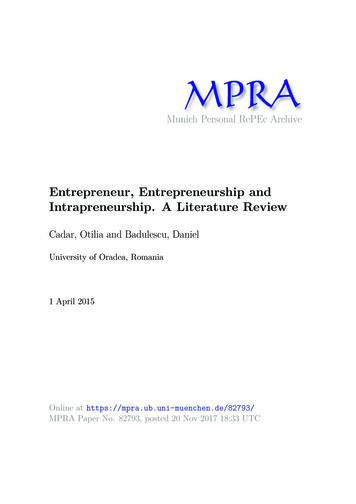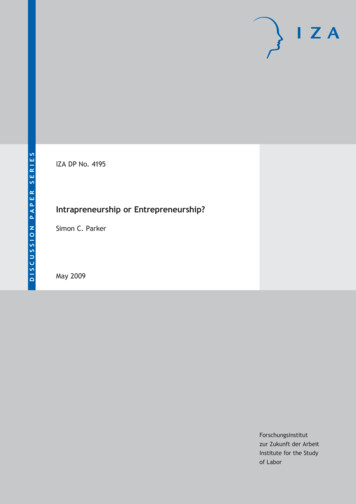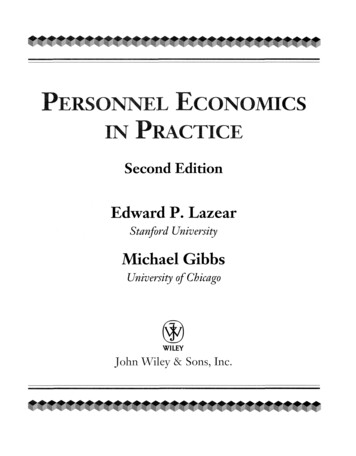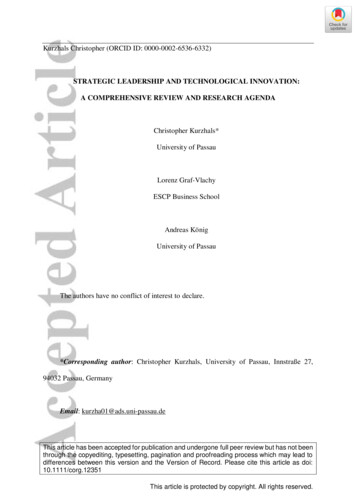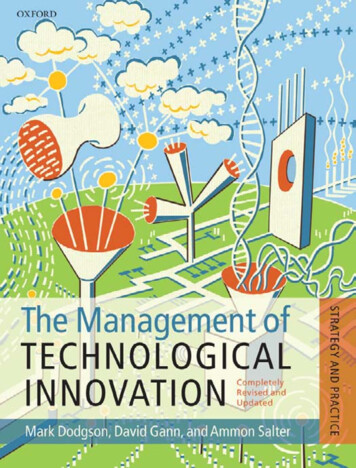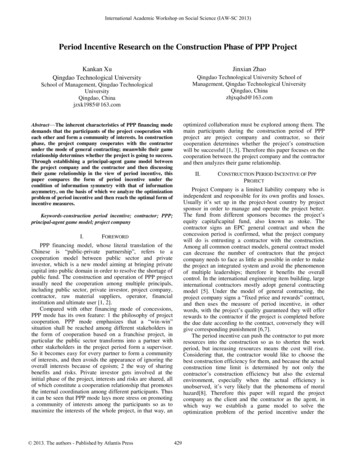
Transcription
Mulungu et al.Journal of Innovation and Entrepreneurship(2021) rnal of Innovation andEntrepreneurshipOpen AccessRESEARCHIntrapreneurship and technologicalinnovation in optimizing qualitative researchas evidenced at Infectious Diseases Institute,UgandaKenneth Mulungu1* , Proscovia Katumba2, Rosalind Parkes Ratanshi1, Adelline Twimukye1,Barbara Castelnuovo1, Aidah Nanvuma1 and Godfrey ious Diseases Institute,Kampala, UgandaFull list of author informationis available at the end of thearticleAbstractBackground: Discrepancies between what is transcribed and the actual interviewrecordings were noticed in qualitative research reports. This study aimed at the development of a new transcription software (Jiegnote), and the evaluation of its effectiveness in the optimization of the transcription process, to minimize transcription completion time, and errors in qualitative research.Methods: The study was a mixed methods project implemented from September toNovember 2020. The qualitative aspect of the study was phenomenological in perspective whereas the quantitative consisted of a randomized controlled trial (RCT) witha parallel design.Results: At the time of the study, the Jiegnote software was a working prototype. Weenrolled a total of 26 participants; 14 participants had their data analyzed in the RCTpart of the study, 13 participated in the in-depth interviews, and 22 in the answering ofSemi Structured Questionnaires. Upon the execution of an independent t test, resultsshowed that, there was no statistical significance between the intervention and controlmeans. On considering the total average transcription completion time and the type oflanguage in which an audio case was recorded, the effect size evaluation implied thatthe Jiegnote software had a small impact (Hedges’ g 0.413438) in reducing the totalaverage time taken to translate and transcribe audio cases that were recorded in a locallanguage (Luganda), and a large impact (Hedges’ g 1.190919) in reducing the totalaverage time taken to transcribe audio cases that were recorded in a foreign language(English). On considering the total average number of transcription errors and the typeof language in which an audio case is recorded, the effect size evaluation implied thatthe Jiegnote software had a small impact (Hedges’ g 0.213258) in reducing the totalaverage time taken to translate and transcribe audio cases that were recorded in a locallanguage (Luganda). This was further observed (Hedges’ g 0.039928) in the transcription of cases that were recorded in a foreign language (English). On considering thein-depth interview data outcomes, participants responded that the Jiegnote softwaremedia looping functions (algorithm) enabled them to accomplish their transcriptiontasks in a shorter time and with fewer errors compared to the traditional methods. The Author(s), 2021. Open Access This article is licensed under a Creative Commons Attribution 4.0 International License, which permitsuse, sharing, adaptation, distribution and reproduction in any medium or format, as long as you give appropriate credit to the originalauthor(s) and the source, provide a link to the Creative Commons licence, and indicate if changes were made. The images or other thirdparty material in this article are included in the article’s Creative Commons licence, unless indicated otherwise in a credit line to the material. If material is not included in the article’s Creative Commons licence and your intended use is not permitted by statutory regulation orexceeds the permitted use, you will need to obtain permission directly from the copyright holder. To view a copy of this licence, visit http:// creat iveco mmons. org/ licen ses/ by/4. 0/.
Mulungu et al. Journal of Innovation and Entrepreneurship(2021) 10:47Conclusion: The study demonstrates utilities associated with intrapreneurship andtechnological innovation in an organization setting whereby, the Jiegnote technologythat was developed by the researchers, had some impact on the optimization of thequalitative research value chain. This was observed through the effect size (impact)evaluations that were conducted to investigate the superiority of the Jiegnote softwareagainst the traditional transcription methods, in minimizing the average number oferrors committed, and time taken to complete a transcription process.Keywords: Intrapreneurship, Technological innovation, Qualitative researchoptimization, Transcription and translation errors, Business process reengineeringBackgroundTranscription involves processes that convert audio data into text, and achievingquality utility outcomes in transcription requires skilled labor.Constraints associated with achieving quality outcomes from qualitative researchprocesses have been observed whereby, discrepancies between what is transcribedand the actual audio interview recording, exist in some qualitative research study initiatives (Holstein & Gubrium, 2003).Studies implicate that, some researchers hardly give transcription quality, a priority(Holstein & Gubrium, 2003) and that, transcriptionists mistake some wordings forothers that are not in line with the interview context due to the poor recording quality. Furthermore, the process of running recorded information on audio players; backand forth, to replay a section of an audio file during transcription, leads to omissionand the misinterpretation of some words. It was further observed that, the placementof a coma in a phrase sometimes altered the meaning of a sentence. Transcripts neverexhibited expressions like; intonation, mimicking of people, or respondents quotingothers, therefore, annotations were omitted in some transcribed data. (Holstein &Gubrium, 2003).Both naturalism and denaturalism make up the two domains of the transcription process. (Oliver et al., 2005). With naturalism, all utterances are captured in the text whilewith denaturalism, idiosyncratic elements of speech like pauses and nonverbal sentiments are omitted. On choosing between the two domains, researchers argued that theresearch question influenced one’s preference and that denaturalism leads to the omission of information that could be relevant in data analysis.There are difficulties in; decoding pronunciation, vocalizations, non-verbal communication, and irregular grammar during the transcription process (Oliver et al., 2005).With pronunciation, slangs are used, and upon the recording process, the audio recorders poorly store the data. Furthermore, geo-ethnic accents create misunderstanding andconfusion during the transcription of conversations.The transcription process is time and labor intensive. Generally, this process is implemented by a variety of professionals like; administrative staff, graduate students, andnon-research professionals with varying skills, training, and supervision; hence, posingthe risk of poorly transcribed data (Hennink & Weber, 2013). Furthermore, the use ofmultiple transcribers led to the variance in quality, and content of the transcribed data.Uganda is a multilingual and a multicultural country, with more than thirty spokennative languages. The languages can be grouped into three main categories; Bantu, Central Sudanic, and Nilotic. (Sawe, 2017). The multilingual nature of Uganda poses a riskPage 2 of 17
Mulungu et al. Journal of Innovation and Entrepreneurship(2021) 10:47of improper translation and transcription of data during qualitative research serviceprovision.The Infectious Diseases Institute (IDI), a non-government organization (NGO), inKampala, Uganda, is a healthcare research setting that conducts; quantitative, qualitativeand mixed methods research projects in various African communities.The traditional transcription process at IDI, requires employees to work with twocomputer programs; a word processor (Microsoft Word), and an audio player (MicrosoftWindows Media Player). Researchers and their assistants switch back and forth betweenthe word processor and the audio player to convert audio data into text (transcription), consequently, this makes the transcriptionists less productive due to the iterationbetween the audio player and the word processor applications. This is evidenced withthe longer time frames to accomplish the transcription processes in some research projects. The iterative process between two computer applications in the traditional transcription methods and the operational gap of longer transcription time, is due to the lackof a single dedicated optimization software to aid employees in the easier, and efficientimplementation of transcription tasks during qualitative research activities. As staff andresearchers at IDI, we decided to solve the transcription bottleneck through intrapreneurship and technological innovation.With the assumption that an intrapreneural organizational work approach enhanceslabor productivity and innovation, the study aimed at the development of a new transcription software called Jiegnote, and the evaluation of its effectiveness in the transcription of audio files, at the Infectious Diseases Institute, in Kampala, Uganda.Literature reviewIntrapreneurship and innovationIntrapreneurship refers to initiatives by employees in organizations to undertake newbusiness activities (Bosma et al., 2010). These employees are inventive and are entrepreneurial within organization perimeters (Desouza, 2011).Intrapreneurship is a subsection of the corporate entrepreneurship concept, unfortunately, there is little literature focused on the provision of guidance to employees andmanagers on how to implement it, and that, few managers are able to articulate and communicate the process of intrapreneurship to their subordinates (Desouza, 2011). Somestudies implicate that intrapreneural organizations endeavored to provide resources(Finance and time) to their employees to work on new ideas that could be valuable to anorganization’s development, however, such support was not observed in most of otherfirms that were not intrapreneural (Desouza, 2011).Intrapreneurship is a multilevel construct that affects an organization at any levelof its structure and that, it is inclined towards the bottom up management approach.Many research studies on intrapreneurship are limited for their focus is highly directedtowards an organization’s characteristics, hence excluding factors associated with individual (employee) characteristics (Neessen et al., 2019).A study on entrepreneurship by Bosma (2010) and his team implicated that intrapreneurship was prominent in high income countries as compared to low income ones,and that, intrapreneurs possessed entrepreneurial perceptions and attitudes, as a result,low income countries miss benefits associated with intrapreneurship. The study furtherPage 3 of 17
Mulungu et al. Journal of Innovation and Entrepreneurship(2021) 10:47stipulated that intrapreneurship was a special type of entrepreneurship with a numberof shared behavioral characteristics, however, intrapreneurship faced the limitation ofcorporate hierarchy as it belonged to the domain of employee behavior.Intrapreneurship and innovation disciplines complement each other for they allinvolve creation of products or services. There are a lot of arguments (discrepancies)pertaining to the right definition of an innovative product or service, and therefore,innovation definitions have evolved depending on the stage of development of industries. In the early 1960s, the innovation discipline was defined in line with the manufacturing industry whereby research and development led to new products that werepatented, and that, an innovation was generally acknowledged in terms of a physicalproduct that was new (Schachter, 2018).Unlike the 1960s views on innovation, scholars in the modern age of industrial development, view innovations in multiple contexts. Some scholars have argued that forsomething to be innovative, it should include some or all of the following factors; novelty, invention, or change (Schachter, 2018), and that an innovation can either be tangible or intangible.In their published book, Ton et al. (2005), described innovation as an idea, practice, orobject that is perceived as new by an individual or other unit of adoption, and that, thecharacteristics of an innovation, as perceived by the members of a social system, determines its rate of adoption.According Weisberg (2006), for something to be an innovative (creative) product, itmust be new and that, there are two novelties that must be separated in the creativeprocess, that is to say; novelty of a person, versus that of the world. If an individualdeveloped a product and he or she was not aware that the product had been developedsomewhere else, then that individual is creative for the idea of the product was novel tohim or her, therefore, Weisberg argues that for a product to be creative or innovative, itshould encompass novelty by the creator, and that a creative person is one who producessuch products. Furthermore, Weisberg stipulated that if a product was created accidentally without intentional novelty, then the incidence is not creativity.From the literature review, we observe that both, intrapreneurship, and innovationinvolve artifact development, and that, the definition of an innovation depends on thedevelopment context of the product or service of the creator (innovator) in a social system, however, scholars conclude that at least, an innovative item has to be novel. In thisstudy, we define an innovation as something that is new or improved in such a way thatthe target population for the innovative item acknowledges the novelty of the new product or service. Furthermore, we define intrapreneurs as people who voluntarily come upwith new developmental concepts (ideas, services or products) within their host organizations regardless of their position (manger, or not a manager) and the type of organization (profit, or not for profit).Theoretical frameworkThis study involved the development of a new product (Jiegnote) and the evaluation ofits effectives in the optimization of the qualitative research value chain through reducedtranscription errors and completion time compared to the traditional transcriptionPage 4 of 17
Mulungu et al. Journal of Innovation and Entrepreneurship(2021) 10:47methods. Therefore, the new product development theory was used as a theoreticalframework for the research project.New product development theoryAccording to Gurbuz (2018), a product is an object or service which is functional andemotional to satisfy the customer’s need, avail value, and be delivered as the way customer demands. Products take shape, and hence they can either be tangible or intangible. New product development can result into a new profit or a loss however, it wasnoted that if a new product was introduced at the right time in the market, it was morelikely to create significant amounts of profits to the host organization (Gurbuz, 2018).Gurbuz further stipulated that a new product can take several categorizations whichmay include; (1) Major innovations, (2) Product improvements, (3) Product additions,and (4) Repositioned products, and that, the new product development process undergoes eight stages, and in each stage, business decisions should be critically made to guidethe next step in the implementation of another stage.Stage 1: Generation of new product ideasThis stage involves coming up with a series of new product ideas. Ideas can come from;research and development departments, competitors, customers and employees amongother sources. The Jiegnote software idea was generated through the observation of thetranscription processes at IDI. The Idea was then forwarded to the research departmentmanagement for analysis.Stage 2: Screening and evaluation of ideasIn this stage, ideas are screened and priority is given to those that meet the higher valuedepending on the organization’s priority matrix. The IDI research department evaluatedthe Jiegnote software idea within 14 days from the time of its initial submission.Stage 3: Concept development and testingIn this stage, the screened and selected ideas are organized in a detailed and meaningfulform. Potential customers’ thoughts are taken up pertaining to the new product initiative, and the product concept that receives the best score, is selected as the new productto be developed. Detailed documentation of the Jiegnote transcription software idea wasmade, and a group of qualitative researchers were selected to provide information pertaining to the usefulness of the software in their work processes. Upon the validation ofthe Jiegnote value proposition, a decision was made to have the sample (working prototype) version of the software developed.Stage 4: Marketing strategyThis stage involves establishing a marketing strategy for the considered concept. A seriesof factors are put into consideration. These may include; profitability, price, distributionand market for the new product. Investigations associated with factors like; the propensity to buy, to recommend, and to adopt the Jiegnote software, were conducted by issuingself-administered questionnaires to potential clients (Researchers and their assistants).Page 5 of 17
Mulungu et al. Journal of Innovation and Entrepreneurship(2021) 10:47Stage 5: Business strategy/analysisIn this stage, projections on sales, profits and costs, pertaining to the new productdevelopment process are made. If the analytics indicate significant (positive) returnsin line with the business objectives, then stage 6 on product development is initiated.The Data from the questionnaires pertaining to the Jiegnote software value proposition was analyzed, and the outcomes indicated that, there was a higher propensity toconsume the software.Stage 6: Product developmentA Sample of the new product is created and tested amongst customers to evaluate itsattractiveness, and potential uptake in the market. The Jiegnote software was developed to a minimal viable product (MVP) level through agile software developmentprocess. (Akbar et al., 2018).Stage 7: Test marketingTests are made in this stage to guide the appropriate and effective marketing initiatives that will maximize returns on investment. This stage helps to minimize unnecessary costs that may impede high profitability in the commercialization stage. Thisstudy was conducted among 26 IDI transcribers. The study data was to be used in thedevelopment of an effective strategy that would achieve a high consumption (adoption) rate of the Jiegnote software in the future.Stage 8: CommercializationThis stage involves determining when to introduce the new product into the market.Considerations are made pertaining to the scale of introduction of the product to themarket. It may be regional, national or international scale.The framework (Fig. 1) lists three factors; innovators, products/services, and adoption, that influence a desired outcome of optimized transcription process in qualitative research.Innovators Intrapreneurs work within their employers’ boundaries and hence, theorganization’s environment plays a significant role in influencing what is to be innovated. This is why both the intrapreneurs and the organization are categorized underinnovators in the framework.Product/service The new products and services are the innovations created by innovators. In this study, the Jiegnote software is the new product that creates a new transcription work approach (service) in qualitative research value chain of IDI, Uganda.Adoption This section represents the perceptions of the potential adopters for thenew products and services. The perceptions include; ease of use, ease in learning,financial cost, accessibility, knowledge, benefits and threats among others.Optimized output The optimized output is the target desired outcome due to thethree preceding factors as listed in Fig. 1. The effectiveness and efficiency are thebroad factors used to evaluate the impact of the predictor factors. Time taken to transcribe audio data using the Jiegnote software compared to the traditional methodsfalls under the efficiency factor and the proportions of transcription errors observedPage 6 of 17
Mulungu et al. Journal of Innovation and Entrepreneurship(2021) 10:47Page 7 of 17Conceptual FrameworkInnovatorsOptimized outputProduct / ServiceAdoption-Ease of use-Ease in logy-Financial cost-Effectiveness-ReengineeredTranscriptionwork ts-ThreatsFig. 1 Jiegnote conceptual frameworkwhen using the Jiegnote software compared to the traditional methods falls under theeffectiveness factor.MethodologyWe used mixed methods in the research project. This was aimed at assessing whetherwe could get related outcomes in the qualitative and experimental parts of the study(Regnault et al., 2018; Schoonenboom & Johnson, 2017). Furthermore, we wanted toinvestigate the study topic in multiple contexts (O’Cathain et al., 2007). The qualitative aspect of the study was phenomenological in perspective for the lived experiences of participants in line with the Jiegnote software were evaluated whereas thequantitative component of the study consisted of a randomized controlled trial (RCT)with a parallel design (Spieth et al., 2016). Furthermore, the RCT was used to measure the effectiveness of the Jiegnote software intervention in a transcription process(Hariton & Locascio, 2018).The study was conducted from September to November 2020 at the Infectious Diseases Institute (IDI), in Kampala, Uganda, which is part of Makerere University, Collegeof Health Sciences. The organization hosts qualitative, quantitative and mixed methodsresearchers who were important in giving responses during study activities.Our sample population consisted of IDI staff in the behavioral science peer group. Thepeer group involves trained professionals responsible for the transcription and translation of audio files in some IDI research projects.To meet the study inclusion criteria, participants had to have prior experience in thetranscription of audio recordings, provide a written informed consent, and had to beaged 18 years and above. Participants who did not comply to study procedures wereexcluded from the study.
Mulungu et al. Journal of Innovation and Entrepreneurship(2021) 10:47Study procedures and data collectionThe Jiegnote Software developmentThe Jiegnote software was expected to read videos and audios, and furthermore, recordtexts concurrently to allow transcriptionists transcribe data with only one computerprogram. The software was also expected to effect a media looping algorithm that facilitates audio clarity, and the convenient creation and working within audio loops, duringthe transcription process, hence preventing transcribers from switching back and forth,between a word processor, and an audio player when converting audio information intotext. Therefore, Jiegnote, a single automated software application, was intended to provide; an efficient work process, minimal errors, and reduced time in the transcriptionprocess, compared to the traditional transcription methods that were labor intensive,error prone, and required the use of two software applications when transcribing audiodata.In relation to the new product development theory (Gurbuz, 2018), the data collection tools were pretested and piloted whereby, a group of 5 participants who had priorexperience in transcription was formed, and later interviewed in line with the observedtranscription challenges. The generated data helped us to understand the inefficienciesof the traditional transcription methods, and furthermore, we were able to develop theJiegnote transcription software at a minimal viable product level.The software incorporated an audio player and a word processor on one interface,therefore, the end-users worked with only one tool when transcribing their recordednarratives, unlike the traditional methods that involved clients working with two separate software applications. Furthermore, the Jiegnote looping algorithm was developedin a way that ensured information reemphasis and clarity, to minimize transcriptionomission and insertion errors.Jiegnote software evaluationStudy participants were randomized into two groups. Four audio cases which are; case a,b, c and d, were used for transcription by the groups. The first two cases were in Lugandalanguage and the remaining in English.Participants were assigned study Identification numbers (IDs) that were confidential.The investigator and research assistants were not able to tell participant names that corresponded to the study identification numbers. The participants were informed aboutthe confidentiality. This was intended to mitigate any potential bias or confounding factors during the answering of questions since the lead researcher was a co-worker to thestudy respondents.The Jiegnote software was presented to the study participants who were trained onhow to use it in the transcription process. A return to demonstration was effected amongparticipants when learning the software. The audio files in Luganda language were translated and transcribed by participants to English during the study activities.Fast pacing is when an audio file speed is altered to an extent that it is faster than itsoriginal recorded state. For example, an audio file playing at 25 s per frame can be fastpaced to 50 s per frame. “A” and “C” cases were fast paced whereby, their original speedswere doubled using an audio file editor, unlike “B” and “D”.Page 8 of 17
Mulungu et al. Journal of Innovation and Entrepreneurship(2021) 10:47The lead researcher and an experienced senior qualitative researcher transcribed allthe four audio cases to create four written transcripts (master files), that were later usedas benchmarks in determining the differences in outcomes (transcription errors andcompletion time), between the use of the Jiegnote software and the traditional transcription methods among respondents.Participants were randomly categorized into two groups that were given the fouraudio case files; a, b, c and d, to transcribe using the Jiegnote software and the traditional methods. There was timing of sessions to determine duration taken to finish thetranscription of each audio case per participant. The study ensured that each participanttranscribes two audio cases using Jiegnote software (intervention) and two other onesusing the traditional method (control).In the last stage of the Jiegnote software evaluation, questionnaires were issued, andin-depth interviews conducted among participants. This stage’s inclusion criterion stipulated that; a participant should have transcribed at least one audio case using the Jiegnote software.Data analysisWhen considering the quantitative component of the study, we used an independent ttest to evaluate the statistical significance between the intervention and control groupaverages (Kim, 2015). The Hedge’s g test was used to determine the magnitude of theintervention on the total number of transcription errors and completion time (Brydges,2019).On considering the qualitative component of the study; transcribed content from theuse of the software versus the traditional method was evaluated for accuracy (errors)and time of completion. The transcription errors were categorized into word and annotation errors. These categories were further broken down into omission and insertionerrors. Word omission error is when a transcriber misses out a word or series of wordsto an extent that meaning of the original recorded narrative is altered. Annotation omission error is when a transcriber misses out an annotation or series of annotations to anextent that meaning of the original recorded narrative is altered. Word insertion error iswhen a transcriber adds a word or series of words into a transcript to an extent that themeaning of the original recorded narrative is altered. Annotation insertion error is whena transcriber adds an annotation or series of annotations into a transcript to an extentthat meaning of the original recorded narrative is altered.During the In-depth interview data analysis study stage, the transcribed recordedaudio data and the text one from self-administered questionnaires were analyzed usingthe inductive thematic analysis method. Transcript texts of interest were varyinglyhighlighted by coloring, and codes generated with brief description of the highlightedphrases. The created codes were evaluated to identify patterns and hence facilitatethe development of themes, however, some codes were grouped under a single themedepending on their patterns.The themes were later reviewed to assess their usefulness to the study and a final listof them was created, named and defined to bring out meaning. This data analysis stageof the study involved three researchers that independently generated study codes andthemes per transcript, to limit potential bias when yielding meaning from the qualitativePage 9 of 17
Mulungu et al. Journal of Innovation and Entrepreneurship(2021) 10:47Page 10 of 17data. The final themes had to be agreed upon by all the three researchers to be part ofthe study results.Ethical considerationsInstitutional Review BoardThe study was approved by the School of Biomedical Science, REC (SBS-783) and theUganda National Council for Science and Technology (SIR38ES).ResultsStudy enrolmentWe enrolled 26 participants; 13 participated in the in-depth interviews and 22 in theanswering of Semi Structured Questionnaires. Out of the 14 participants in the randomized controlled trial; group one consisted of 8 while group two consisted of 6participants.Transcription errors, and completion timeTables 1 and 2, show the time taken by each participant to complete the transcription ofthe audio cases; A, B, C a
of improper translation and transcription of data during qualitative research service provision. e Infectious Diseases Institute (IDI), a non-government organization (NGO), in Kampala, Uganda, is a healthcare research setting that conducts; quantitative, qualitative and mixed methods research projects in various African communities.
